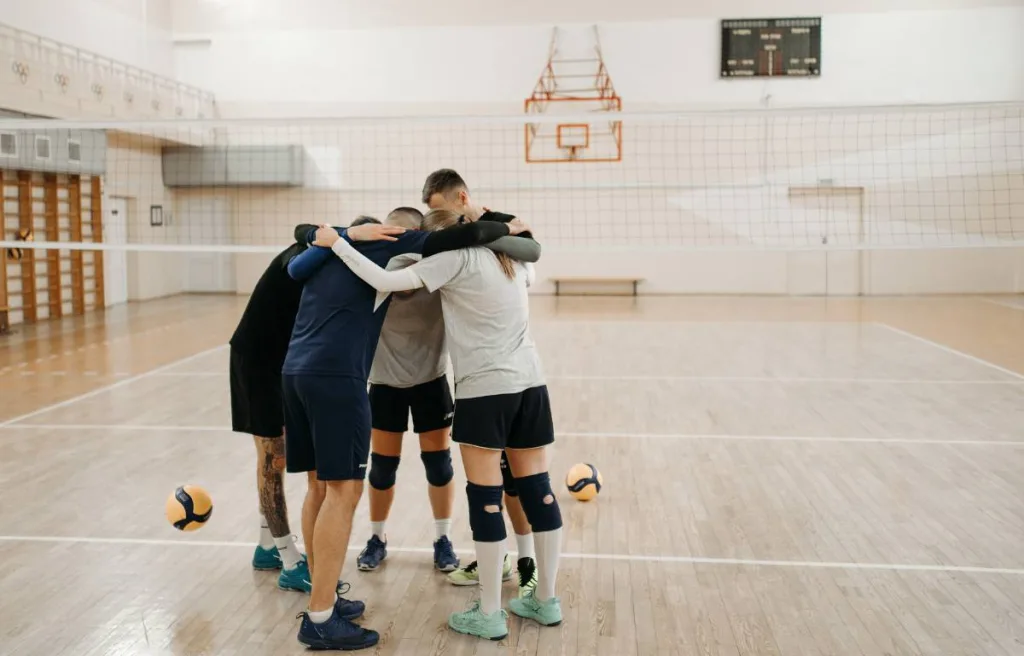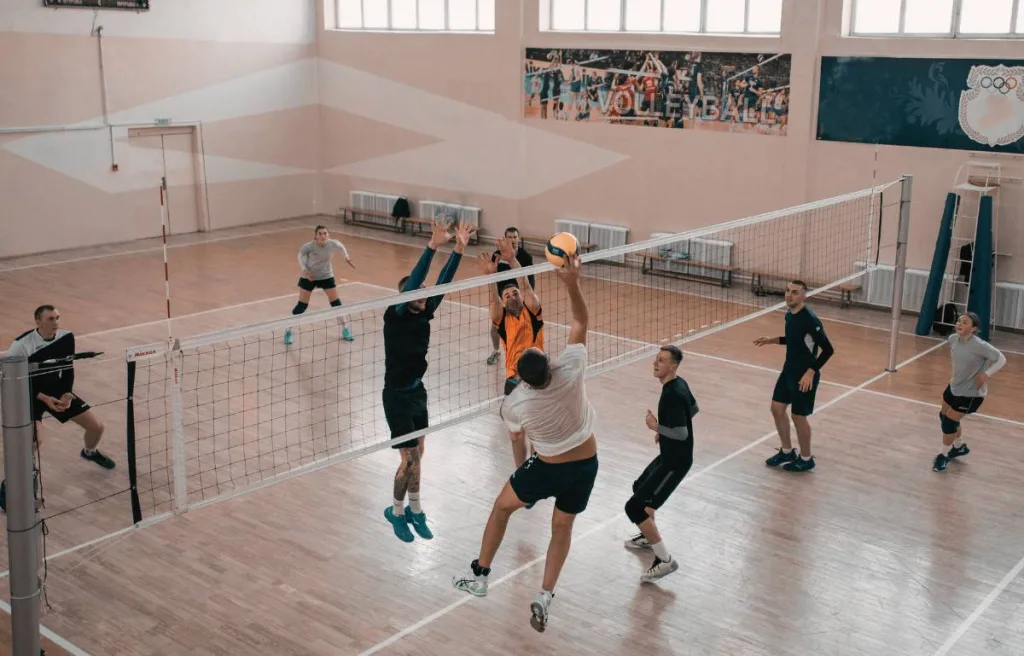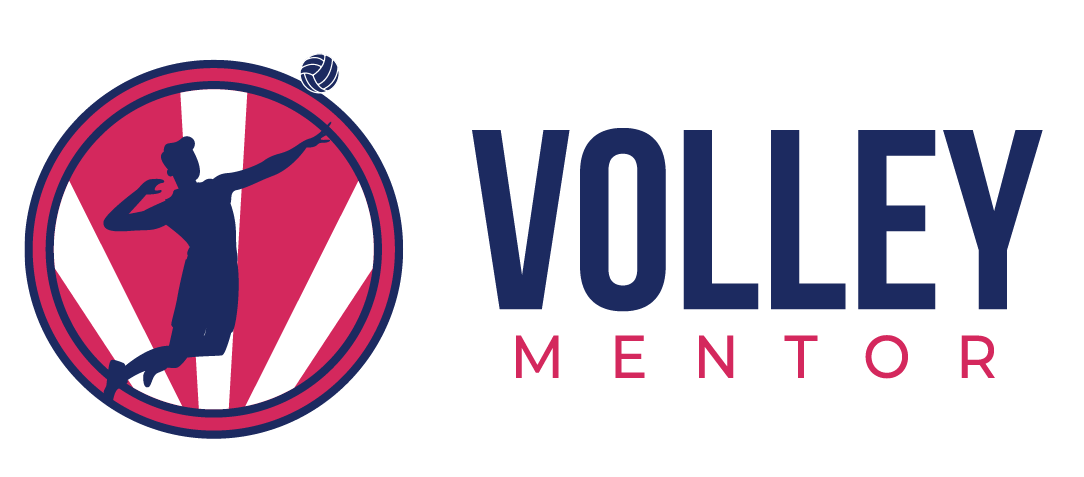Expert Insights into Middle Blocker Volleyball Position

Growing up, you might have heard that height is a must for playing volleyball.
While not entirely true for every position, this certainly holds weight regarding the middle blocker volleyball position.

He is usually the team’s tallest member and stands ready at position number 3 like a watchful giant.
Quick Answer: The middle blocker in volleyball is typically positioned in the middle of the court and plays a critical role in offense and defense. Their role demands physical attributes such as height and agility and skills like swift lateral movements, effective blocking, and strategic court placement.
In this guide, I will discuss middle hitter’s responsibilities in detail and explain what skills and attributes set them apart from their teammates.
I will also share some tips and drills to help you become an exceptional middle-blocker.
Stick with me to the end for some informative insights about this role that could take your game to new heights.
What is a Middle Hitter in Volleyball?
The middle hitter, or the middle blocker, is a central figure in volleyball, and a team can have up to two of them on the court simultaneously.
The tallest players on the team fill this position and typically have an exceptional vertical jump compared to their other teammates.
Their height gives them a significant advantage in many aspects, allowing them to reach higher and cover more area.
Also, they are strategically placed in the front row at the net, dominating with quick attacks and blocks.
When rotated to the back row, middle hitters have a more defensive focus.
However, they are often substituted for the libero to maximize the team’s defensive capabilities.
Regarding the rules, they follow the same regulations as other volleyball players, but there are some precautions that I want to discuss here.
Since middle blockers are often right up at the net, they must be extra careful not to touch it.
Touching it can cost their team a point.

Moreover, they must be quick when blocking and hitting the ball near the net.
They should not hold the ball too long, which would result in a lift violation.
Interestingly, there’s a special rule for middle blockers (MBs) during a defensive play in volleyball.
If they try to block a ball and it touches them more than once, it’s still considered legal.
It means that if the ball hits the MB’s hands and then another part of their body during a block, it’s not a fault.
It’s counted as one action, not multiple contacts, and would not be a double-hit violation.
This rule helps them defend more effectively at the net.
What does the Middle Blocker do in Volleyball?
Most people think the middle blocker role is only in the front row.
But that’s not true, as he is responsible for various tasks that influence the team’s offense and defense.
To elaborate on this concept in detail, I have done a detailed breakdown of the key responsibilities of MBs:
1) Dominating at the Net: Blocking
I call middle blockers as the towering fortress at the net.
The reason is that they quickly assess where the ball is heading after the spike from the opponent’s hitter.
They position themselves strategically and use their height to create an unbreakable wall to spike that blazing-fast hit.
The blocking is their primary job for which they are famous.
But it’s not only about height.
Their timing and hand position to stop the ball is crucial to effectively redirect the opponent’s attack.
2) Attacking: More Than Just Blocking
Middle hitters aren’t just defensive players.
When their team is on the offense, they transition into attackers.
In many intense matches, an MB swiftly approaches the net after a perfect set and often does a quick and powerful spike.
Their attacks are often unexpected and can be decisive in scoring points, exceptionally when executed with speed and precision.
A Middle hitter contributes significantly towards scoring kills for their team, so they are undoubtedly an asset to their team.

3) Net Coverage: Guarding the Territory
Net coverage involves a keen awareness of the entire net area.
The middle blocker needs to be ready for powerful spikes and softer shots like tips or rolls.
For example, if an opposing hitter tries to outsmart them with a tip over the block, they must be agile enough to react and cover that space.
They should also ensure that the opponents cannot score any easy points.
It is a responsibility that involves agility and excellent communication with teammates.
4) Reading the Opponent’s Offense
A successful middle blocker is like a chess player, always thinking a few moves ahead.
They observe the setter and hitters, trying to predict the play.
Will the setter set the ball to the outside hitter or go for a back-row attack?
That’s the question that always revolves around their head.
Understanding these patterns helps the MB position themselves effectively, giving their opponents a tough time.
5) Serving and Back-Row Play
While they excel at the front row, the middle hitters contribute from the back row.
They contribute with serves and participate in back-row defense when not substituted by a libero.
Their serves can add another layer of pressure on the opponent.
But serving is not their core area of expertise, and you rarely see them doing it.
Their back-row skills focus on defensive strategies away from the net.
These skills include proficient digging, retrieving hard-hit balls, and keeping the play alive.
They also have solid serve-receive abilities to counteract the opponent’s serves effectively.
6) Team Coordination
Middle blockers truly serve as the on-court conductors of a volleyball team.
They often call out the positions of both opposite and outside hitters to motivate them and discuss upcoming strategies.
This communication is a cornerstone in organizing the team’s defense.
They ensure every team member is aligned and ready for the opponent’s next move.
Moreover, their ability to see what’s happening and team guidance is essential for winning the volleyball match.

Ideal Physical Attributes for Middle Blockers
Becoming a middle blocker in volleyball is an exciting and challenging journey, especially for those just starting.
As described above, your height is essential in becoming an MB.
But, along with it, this position demands some other specific physical attributes that are crucial for success on the court.
Here’s a list of ideal physical traits for aspiring middle hitters:
How Tall Are Middle Blockers In Volleyball?
When we say middle blockers are the tallest members of a volleyball team, it clearly means that, on average, they stand taller than players in other positions.
This height advantage is crucial, especially when blocking and executing spikes, as it allows them to reach and cover more area over the net.
In professional and international volleyball, male middle hitters often stand between 6’8″ (203 cm) to 7′ (213 cm) tall.
Conversely, female blockers usually range from 6’2″ (188 cm) to 6’6″ (198 cm).
For instance, consider Maxwell Holt from the USA men’s national team.
He is a thriving middle blocker who stands tall at 6’10” (208 cm).
Similarly, Milena Rašić, a notable blocker on the Serbian women’s national team, has an impressive height of 6’3″ (193 cm).
In youth and junior volleyball, the height of middle blockers can vary greatly as players are still growing.
Even at these levels, middle blockers tend to be among the taller players on their teams.
Coaches often look for players who show growth potential and have the agility and jumping ability that the position requires.
At the collegiate and club levels, the height of middle blockers can vary more widely.
Generally, male middle blockers are often around 6’5″ (196 cm) or taller, and female middle blockers are usually at least 6′ (183 cm) tall.

Middle Blocker Volleyball Footwork Pattern
Footwork is the middle blockers’ foundation, enabling them to move efficiently across the court.
It also aids them in both blocking and transitioning into an attack.
Most middle hitters use the 2-step crossover footwork pattern that works excellently.
I am listing down the step-by-step procedure of this pattern below:
- Initial Stance: Start in a balanced, ready position. The feet should be shoulder-width apart and knees slightly bent.
- First Step: This is a large step toward the incoming ball. It’s about covering a significant distance swiftly.
- Crossover Step: Now, use a crossover step to gain more ground. This step involves crossing one leg over the other and pushing the body sideways towards the ball.
- Plant and Jump: After the crossover step, quickly plant both feet and prepare to jump. The jump should be high and timed with the hitter’s attack, and arms should penetrate over the net for an effective block.
- Landing and Transition: After the block attempt, land safely with knees bent to absorb the impact. Now, be ready for another block!
Top Volleyball Middle Hitter Tips: Strategies for Success
The middle blocker volleyball position requires a passion for the game and a dedication to sharpening some specific skills.
If you want to excel in it, remember that you require a blend of physical traits, technical skills, and strategic thinking.
Now, I am sharing some tips that I give to the middle hitters as a coach, and I have seen some exceptional results.
1) Wearing the Knee Pads
Firstly, I can’t emphasize enough that you should invest in quality knee pads to protect yourself, especially when attempting to block or save a ball.
You may hear that middle blockers don’t need them, unlike other players.
But that’s not true.
As a middle hitter, you often dive or fall to the ground while attempting to block or save a ball.
Wearing knee pads cushion the impact and reduce the risk of knee bruises.
Another reason is that regularly playing volleyball can strain the knees.
The knee pads support and reduce stress on the knee joints, which is crucial for long-term joint health.
It also gives you the confidence to make bold moves and dives without fear of injury.
2) Embracing Continuous Learning
The world of volleyball constantly evolves, and new techniques in each position emerge regularly.
As a middle blocker, staying informed and updated is super important.
Watching professional players can inspire new approaches to your game.
Ensure to seek feedback from coaches and teammates because constructive criticism can highlight areas for improvement that you might not have noticed.
Additionally, staying updated with volleyball’s latest rules and techniques ensures that your skills and knowledge remain current and competitive.
3) Focusing on Mental Toughness
Your position as a middle hitter could be as mentally demanding as it is physically.
Developing mental toughness involves training yourself to remain calm and focused under pressure.
You must stay calm, whether it’s a crucial point in a match or facing a tough opponent.
Always adapt to the game’s dynamics, such as changing strategies or dealing with unexpected situations.
Follow my rule of practicing mindfulness and positive self-talk daily, as it can significantly enhance your mental toughness on the court.
4) Prioritizing Proper Nutrition and Rest
It is the least hearing advice that you will hear from the coaches.
Remember that peak physical performance is not just about training and practice.
It also heavily depends on proper nutrition and rest.
A balanced diet provides the necessary energy and nutrients to perform at your best.
It means consuming carbohydrates for energy, proteins for muscle repair and growth, and fats for long-term fuel.
Also, adequate sleep and rest days are essential for muscle recovery, injury prevention, and overall well-being.
Ignoring these aspects can lead to burnout and decreased performance.
So, giving your body the fuel and rest it needs to thrive is vital.

5) Use Hand Signals for Communication
Hand signals are a great way to communicate quickly and clearly without shouting.
Many middle blockers use hand signals before a serve or during a play to let their teammates know their blocking strategy.
For example, they might signal which way to block or how many blockers will go up against the hitter.
Some signals may include holding up fingers to indicate the block type or pointing to areas to show where they will be covered.
I recommend that teams should practice these signals during training so everyone understands what each signal means.
This way, during a game, players can react quickly and effectively.
6) Creating a Wall
When I say “creating a wall,” it means using your hands and arms to block the ball from coming over the net.
It’s like you’re building an actual wall at the net.
This technique is important because it stops or slows down the ball from the other team, making it hard for them to score a point.
To create an effective wall, stretch your arms high and press your hands over the net.
When you’re up at the net, position your hands near each other, almost touching but not quite.
It helps cover a wider area and makes your block more effective.
Also, angle your hands slightly towards the opponent’s courtside.
This way, if the ball makes contact with your hands, there’s a good chance it will bounce back onto their side, not yours.
If your hands are too loose during this process, the ball might push them back and come onto your side of the court.
7) Enhancing Offensive Abilities
As a middle blocker, it’s easy to focus most of your energy and training on blocking since it’s a big part of your role.
However, it’s equally important not to overlook your offensive duties.
Work on your spike technique, timing, and coordination with your setter to execute quick and effective attacks.
Practice different types of hits to become a versatile attacker.
By balancing your focus between blocking and hitting, you’ll become a more well-rounded player and a greater asset to your team.

Effective Training Drills for Middle Blockers
Effective training drills are essential for middle blockers to enhance their skills and performance on the court.
As a middle blocker, your role demands agility, quick reflexes, and strong blocking and attacking techniques.
Here are my favorite drills, each with detailed steps designed to outrank your position.
1) Rapid Block Transition Drill
It is my favorite drill and helps improve your footwork and blocking speed.
The steps are straightforward and listed below:
- Begin in the middle blocker position, centered and ready.
- Wait for your coach’s signal.
- After the signal (simulating the opponent’s set), quickly move towards the designated side of the net.
- Now, it’s time to perform a blocking jump and focus on proper hand positioning.
- After the landing, immediately prepare for an offensive approach.
- Continue this drill by changing the sides, like a real volleyball match blocking.
2) Shadow Blocking Drill
This drill helps you enhance reaction time and blocking accuracy as a middle hitter.
You need a partner acting as a setter in it, and the steps are:
- Start this drill by facing a teammate who acts as a setter and standing on the opposite side of the net.
- When the setter sets the ball, quickly move to the corresponding position to block.
- Focus on your footwork and apply the 2-step crossover to reach the blocking position.
- Perform a mock block, then quickly reset to the original position.
- The setter should vary the direction of sets to keep the drill unpredictable.
3) Vertical Leap Practice
This drill is universal for all the front-row players but specifically helpful for the middle blockers.
It helps to increase jumping height and blocking effectiveness.
The step-by-step procedure is:
- Do a short warmup with a light jog and stretching to prepare your muscles.
- Perform sets of vertical jumps and focus on explosive power from your legs.
- Use a wall or a high net as a marker to aim your jump height. You can even use a basketball net as a marker.
- Your goal should be to reach or surpass the marker with each jump.
- Include short rest intervals between sets to maintain jump quality.
- Continue this drill at least 20 times for better results.
Wrapping Up
From the towering height advantage to their specialized skills in blocking, spiking, and gameplay, middle blockers are key players on the court.
I have discussed various aspects of the middle hitter volleyball position in this guide.
Along with it, I also provided insights into their responsibilities, physical attributes, and practical training drills.
If you are already playing in this position or aiming to become one, the tips and strategies discussed here can help enhance your skills and understanding of this vital role in volleyball.
Remember, continuous learning, practice, and teamwork are the cornerstones of success in this position.
Happy blocking and spiking!
